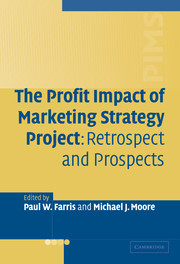Book contents
- Frontmatter
- Contents
- List of figures
- List of tables
- Notes on contributors
- Acknowledgments
- Introduction
- 1 The PIMS project: vision, achievements, and scope of the data
- 2 Putting PIMS into perspective: enduring contributions to strategic questions
- 3 PIMS and COMPUSTAT data: different horses for the same course?
- 4 Order of market entry: empirical results from the PIMS data and future research topics
- 5 Does innovativeness enhance new product success? Insights from a meta-analysis of the evidence
- 6 Marketing costs and prices: an expanded view
- 7 The model by Phillips, Chang, and Buzzell revisited – the effects of unobservable variables
- 8 Causation and components in market share–performance models: the role of identities
- 9 Cargo cult econometrics: specification testing in simultaneous equation marketing models
- 10 PIMS and the market share effect: biased evidence versus fuzzy evidence
- 11 PIMS in the new millennium: how PIMS might be different tomorrow
- Select bibliography
- Author index
- Subject index
- References
9 - Cargo cult econometrics: specification testing in simultaneous equation marketing models
Published online by Cambridge University Press: 22 September 2009
- Frontmatter
- Contents
- List of figures
- List of tables
- Notes on contributors
- Acknowledgments
- Introduction
- 1 The PIMS project: vision, achievements, and scope of the data
- 2 Putting PIMS into perspective: enduring contributions to strategic questions
- 3 PIMS and COMPUSTAT data: different horses for the same course?
- 4 Order of market entry: empirical results from the PIMS data and future research topics
- 5 Does innovativeness enhance new product success? Insights from a meta-analysis of the evidence
- 6 Marketing costs and prices: an expanded view
- 7 The model by Phillips, Chang, and Buzzell revisited – the effects of unobservable variables
- 8 Causation and components in market share–performance models: the role of identities
- 9 Cargo cult econometrics: specification testing in simultaneous equation marketing models
- 10 PIMS and the market share effect: biased evidence versus fuzzy evidence
- 11 PIMS in the new millennium: how PIMS might be different tomorrow
- Select bibliography
- Author index
- Subject index
- References
Summary
An extensive empirical literature seeks to analyze the effects of strategic marketing choices on performance using non-experimentally generated, or “real-world,” data. Research utilizing the PIMS database is an important example. Correct treatment of the strategic choices recognizes that they can be “endogenous” for a variety of reasons, including, but not limited to, reverse causation, simultaneity, omitted variables, sample selection, and measurement error. The standard approach for correcting this problem is to use instrumental variable techniques, such as two- and three-stage least squares, in an attempt to purge the endogenous variation from the strategic choice variables, when these variables are used as regressors in a structural equation.
In estimating simultaneous equation models, three important specification issues arise. First, which of the explanatory variables are potentially endogenous? Second, which of the exogenous variables can be excluded from each structural equation? Third, how important are these excluded exogenous variables as predictors of the included endogenous variables? Accompanying these three issues are three specification tests: the endogeneity tests of Wu (1973) and Hausman (1978), Basmann's (1960) test of overidentifying restrictions, and a simple F-test of the explanatory power of the excluded exogenous variables in the “first stage,” or reduced form of the model. Surprisingly, these tests have not been implemented in tandem to any extent in the literature. As a result, many of the results in this literature should be viewed with caution at best, and skepticism at worst.
- Type
- Chapter
- Information
- The Profit Impact of Marketing Strategy ProjectRetrospect and Prospects, pp. 218 - 259Publisher: Cambridge University PressPrint publication year: 2004

